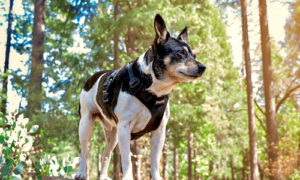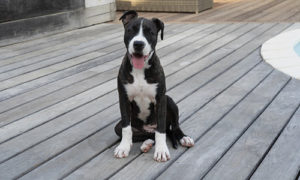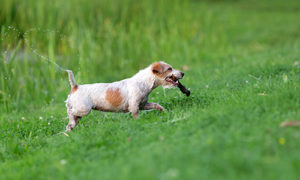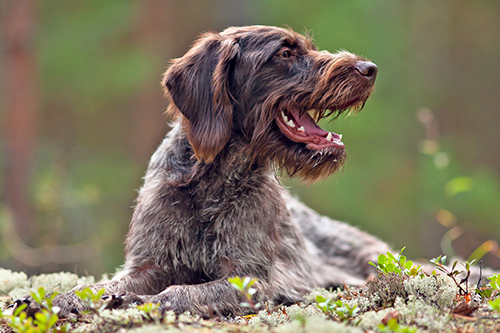
The German Wirehaired Pointer was developed from a combination of the Pudelpointer, Polish Water Dog, German Shorthaired Pointer, and Foxhound in the late 19th century. It was specially bred for versatility and ruggedness as a hunting dog. The GWP was a top-rated sporting dog in Germany for many years before being recognized as a breed in 1928. In the 1920s, the GWP was first imported to the United States. Along with hunting, GWPs are also trained as therapy dogs, canine actors, and drug-detection dogs.
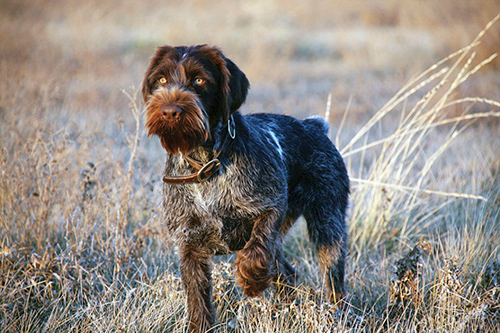
Breed Standard
The German Wirehaired Pointer is well-balanced, sturdy, and medium-sized. Its most popular traits are the facial furnishings and the protective, hard, wiry coat. The head is moderately long, with a broad skull, a medium-length beard, and whiskers with a long muzzle. The nose is dark brown, and the jaw is firm. The dog has oval-shaped eyes that are overhung with bushy eyebrows. Its ears are rounded and hang close to the head. The German Wirehaired Pointer’s overall proportions are rectangular. The dog’s arched neck blends into a sloping backline. GWPs have a deep chest, and the tail is docked and set high while carried at or above horizontal.
Breed Facts
| Energy level | Watchdog ability> | ||
| Exercise requirements | Protection ability | ||
| Playfulness | Grooming requirements | ||
| Affection level | Cold tolerance | ||
| Friendliness toward dogs | Heat tolerance | ||
| Friendliness toward other pets | Friendliness toward strangers | ||
| Ease of training |
- Popularity: Somewhat popular
- Family group: Gundog, Pointer, Versatile Hunting Dog
- Country developed: Germany
- Date developed: 1800s
- Original purpose: General hunting, watchdog
- Today’s purpose: Pointing, pointing field trials, companion
- Other names: Deutscher Drahthaariger Vorstehund, German Pointer (Wirehaired), Drahthaar
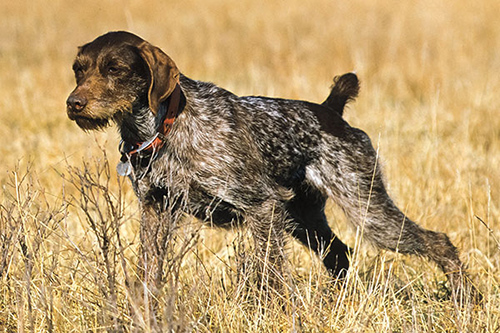
Activity level: High energy. The GWP is a high drive and high-energy hunting dog. They also love to compete successfully in tracking, agility, obedience, field trials and skijoring.
Grooming: These dogs are a low shedding breed. Weekly brushing will help to maintain the coat’s correct harsh texture.
Coat: The coat is weather-resistant and made of a dense undercoat and a harsh, flat, wiry outer coat of 1-2 inches in length. The coat is shorter on the dog’s legs and heads and is denser on the shoulders and tail. The breed has wiry whiskers, eyebrows, and beard.
Color: Liver and white spotted, with or without roaning and ticking; liver roan; solid liver.
Group: Sporting
Year recognized by the AKC: 1959
Germain Wirehaired Pointer Temperament
The GWP has a conventional pointer personality. The dog bonds closely with people, demands human companionship and does not do well in a kennel environment. This pointer can become possessive toward its owners. GWPs are independent, strong-willed, and creative dogs that must have a job to do. Their prey drive is extremely high, which can cause problems with cats and other small pets within the household. The dogs desire to please and respond readily to training like other gundogs.
The GWP tends to be aloof, even protective, towards other dogs and strangers because it retains a guarding instinct. It is usually good and overly energetic, with children once in a while. The dog is an ideal companion for those families that are out-door oriented and want a weather-proof, intelligent, and tireless partner.
Health
- Main concerns: CHD
- Minor concerns: hypothyroidism
- Rarely seen: seizures, entropion, elbow dysplasia, heart disease, gastric torsion, vWD
- Recommended tests: hip, elbow, cardiac, thyroid, eye, (vWD)
- Life span: 12 to 14 years
- Weight: 45 to 75 pounds
- Height: Male – 24 to 26 inches; Female – smaller but not under 22 inches
Breeder and Buyer’s Advice
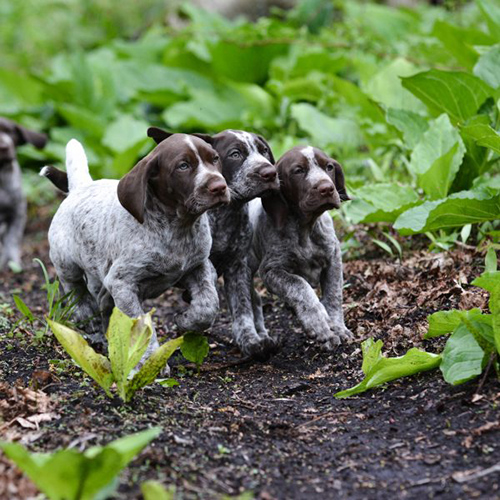
Breeders with the GWPCA provide the following paperwork to all buyers of their puppies:
- A sale or co-ownership agreement
- AKC registration papers or application
- feeding and training advice
- veterinary records
- three-generation pedigree
- copy of the club’s code of Ethics
Parent club: German Wirehaired Pointer Club of America (www.gwpca.com); founded in 1953
Regional clubs: There are about a dozen regional GWP clubs in the United States; information is on the club’s parent website.
Rescue: National German Wirehaired Pointer Rescue (www.nationalgwprescue.com)


